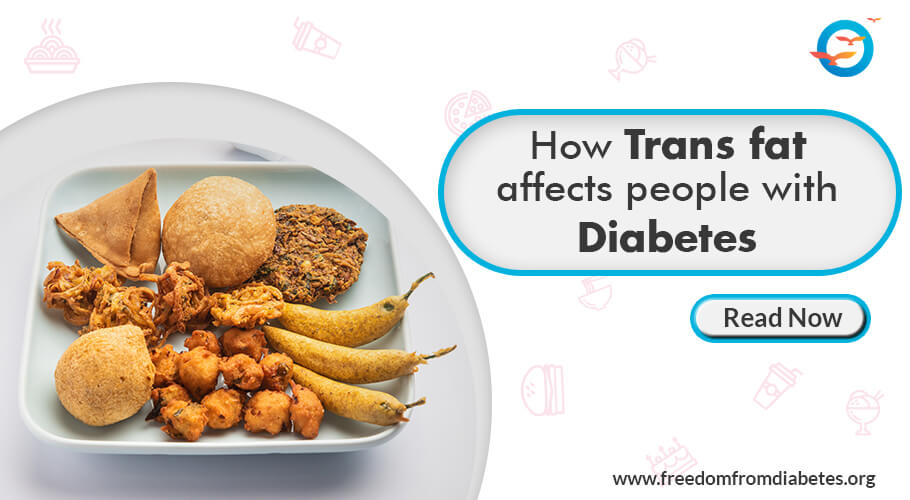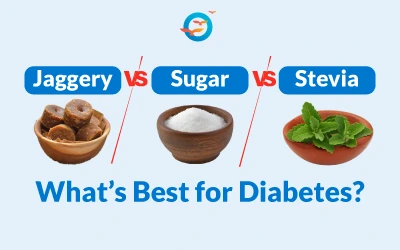Trans fats and the correlation with Type 2 diabetes

How do trans fats influence Type 2 diabetes?
In addition to controlling our intake of carbohydrates, people who are at high risk of developing Type 2 diabetes must also keep watch on their intake, by eating the right quantities of the right type of fat.
While some amount of the right kind of fat is necessary for healthy people, trans fats are quite avoidable because of the health complications that they can give rise to. But more specifically, trans fats are an absolute No! No! for people who have a predisposition to diabetes.
This is because there is enough clinical evidence to show that trans fat could impair insulin sensitivity in individuals who are insulin resistant or prediabetic. In addition, trans fats also cause weight gain which is again another trigger for developing type 2 diabetes.
When we have insulin resistance, it is harder for the body to burn food for energy. This increases the blood sugar level in the body, and when too much sugar builds up in the bloodstream, we increase the chances of type 2 diabetes. Substituting trans fats with healthy fats can reduce insulin resistance and the chances of developing type 2 diabetes.
Trans fat can also influence our blood cholesterol levels. It is considered more harmful than saturated fat. Therefore, a healthy diet includes eating as little trans fat as possible by avoiding foods that contain it.
What are trans fats?
Trans fats are a kind of dietary fat that is recognized as being very detrimental to good health. In fact, of all the different kinds of fats – Unsaturated fats, Saturated fats, and Trans fats, Trans fats are considered to be the worst.
This is because excessive amounts of trans fats in our diet increase our risk of cardiac diseases, Type 2 diabetes, and other health problems.
Trans fats are commonly found in several food items because they are less expensive. Their properties help to extend a product’s shelf life and make it less likely to turn rancid, provide stability, and improve the taste of food.
When an oil containing trans fats is used for frying, it can be used for a longer duration because heat does not break it down as rapidly. This makes it a favourite among restaurateurs and snack-makers who use it for frying, baked goods, processed snack foods, and margarine. They are not mindful of the harm that trans fats can cause.
Trans fats act in a harmful manner on the heart, blood vessels, and rest of the body by
- Raising bad LDL and lower good HDL
- Creating systemic inflammation in women, which is related to immunity and has been observed in patients with heart disease, stroke, diabetes, and other chronic conditions
- Contributing to insulin resistance
How are Trans fats formed?
Trans fatty acids are formed when liquid oil is converted into solid fat such as shortening or margarine through industrial partial hydrogenation - a process that is widely used to produce solid fats. Hydrogenation includes heating liquid vegetable oils in the presence of hydrogen gas and a catalyst.
The process of hydrogenation converts one form of monounsaturated fat (cis) into another (trans) by moving a hydrogen atom from one side of a double bond to the other.
Small amounts of trans fat can also be found naturally in ruminants such as cows, sheep, and goats, and in animal products like meat, milk, and milk products.
Which foods contain trans fats?
Trans fats can be found in several fried foods like:
- Pies
- Cakes
- Muffins
- Cookies
- Spreads
- Crackers
- Pie crust
- Fast foods
- Margarine
- Doughnuts
- French fries
- Ready mixes
- Fried chicken
- Creamy sauces
- Canned frosting
- Mozzarella sticks
- Microwave popcorn
- Non-dairy coffee creamers
- Packaged or processed foods
- Ready to use the refrigerated dough
- Vegetable shortening that is used in cooking
While several developed nations have banned the use of trans fats in foodstuff, or at least limited the permissible quantity that it can be used, in less developed nations, it is left to the discretion of the individual or her/ his health provider to alert patients on the harmful effects of trans fats.
Most packaged foods have a mandatory nutrition label that displays the fat content. By reading these labels, we can keep track of the fats contained in the package.
Learn about the link between fatty liver and diabetes. Visit our blog.
Diabetes reversal program
At Freedom from Diabetes, we recommend keeping the intake of trans fats, particularly the manufactured variety found in partially hydrogenated vegetable oil, as low as possible. In brief, our programs advocate eating the right types of food to reduce our risk of type 2 diabetes, cardiovascular disease, certain types of cancers, and other health conditions.
Our Diabetes Reversal Programs, are built on the fundamental protocols of awareness, diet, exercise, stress management, and medical supervision. The programs have created awareness and helped thousands of people reverse not merely diabetes, but insulin resistance itself.
FAQs
What are trans fats and how do they affect my health?
Trans fats are harmful fats found in some processed foods that can increase the risk of Type 2 diabetes, heart disease, and other health issues.
How do trans fats influence Type 2 diabetes?
Trans fats can make it harder for your body to respond to insulin properly. This can cause higher blood sugar levels, which increases the chances of developing Type 2 diabetes.
Can I reverse insulin resistance by avoiding trans fats?
Yes you can, substituting trans fats with healthier fats can reduce insulin resistance and lower the risk of Type 2 diabetes.
Which foods contain trans fats?
Trans fats are commonly found in fried foods, baked goods like pies, cakes, and cookies, margarine, fast foods, and packaged snacks.
How are trans fats formed?
Trans fats are formed during industrial partial hydrogenation, which turns liquid oils into solid fats like margarine and shortening.

